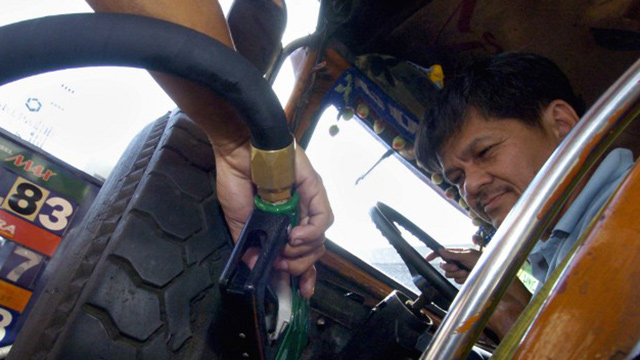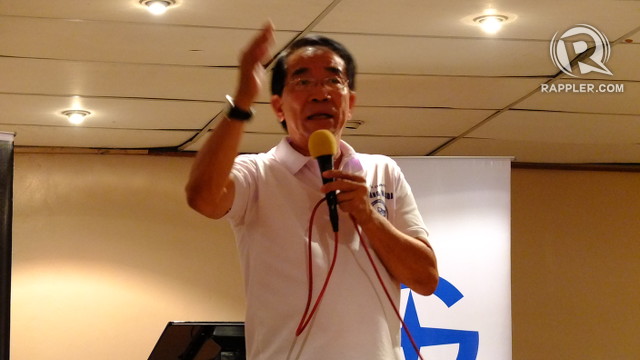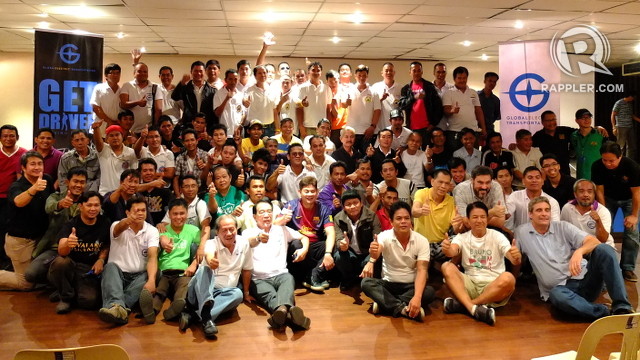SUMMARY
This is AI generated summarization, which may have errors. For context, always refer to the full article.
MANILA, Philippines – Domingo Rivera works 15 hours a day driving his clunky jeepney from Quezon City to Mandaluyong and back again.
His 54-year-old body suffers from the unforgiving heat, air pollution and numbing fatigue. He must compete against other drivers to get passengers because in the dog-eat-dog world of city jeeps, one passenger can be all that stands between him and a meal.
No doubt about it, jeepney drivers have one of the toughest jobs in the city. For all Rivera’s hard work, he takes home only P500 day after paying for gas. He uses this to feed his family and send his 4 kids to school.
But his woes are almost at an end, he told Rappler.
On Saturday, October 26, he and 63 other jeepney drivers finished their training to be the first-ever batch of drivers of a fully electric-powered shuttle called the COMET, short for City Optimized Managed Electric Transport.
In January 2014, 30 COMET units will operate in Metro Manila. From then on, they will ply daily a route from SM North EDSA in Quezon City to SM Megamall in Mandaluyong – passing through Quezon Avenue, University of the Philippines Diliman, Katipunan Avenue, Libis, then Ortigas.
Rivera and his fellow drivers will be the new men behind the wheel of this maiden fleet of COMETs. Global Electric Transport Ltd (GET), the US-based company behind the COMETs, is marketing them as the ideal replacement for the Philippine jeepney. (READ: Welcome E-shuttle, bye-bye PH jeepney)
The COMET runs on state-of-the-art lithium ion phosphate batteries, allowing the shuttle to travel 80 to 100 kilometers a day. Designed for in-city roads instead of major thoroughfares and highways, it runs at a maximum speed of 60 kph.
The 20-seater e-shuttle is also equipped with GPS, CCTV camera and WiFi. A tap-in, tap-out system means drivers and passengers will not be exchanging cash. Passengers simply use a credit-loaded card to pay for the ride. These new features come at no additional cost to consumers. COMET passengers will pay the same fare as passengers of conventional jeepneys.

Goodbye to rising oil prices
The COMET brings much-needed relief to the lives of jeep drivers in more ways than one, said Rivera. But the most striking benefit is how it protects them from rising oil prices.
“Walang humpay ang pagtaas ng presyo ng petrolyo. Nagkaguluhan lang sa Gitnang Silangan, tataas ang presyo. ‘Yun ang problema naming lahat. Dumating na ang tamang solusyon. Dito mawawala na ang ating pangamba na bukas, tataas na naman ang presyo,” said Roberto Martin, national president of Pasang Masda, the jeepney operator GET partnered with for the maiden COMET roll-out.
(Oil prices continue to rise. If there is conflict in the Middle East, the price increases. That’s the problem of all drivers. The correct solution has come. With this, we will no longer worry about oil prices rising tomorrow.)
Rivera said he spends around P1,200 a day to gas up his diesel-based jeepney. This eats into his already meager daily earnings. In contrast, with the electric-powered COMET, he needs to spend P400 to P500 only to have its battery charged in designated stations – only a third of what he would usually spend.
COMET drivers need not be plagued by the common hidden costs of maintaining a conventional jeepney which usually feature weak, second-hand engines and tires which need to be replaced every 9 months because the jeep’s crude brake system and weight continuously burns the tires against road surfaces.
The COMET is 50% more efficient than the jeepneys, using less parts and consuming less fluids, said GET director for communication Armi Consunji. It is also 50% lighter being only 2,500 lbs compared to the jeep’s 6,000 lbs.
A World Bank study concluded that jeepney drivers are the main victims of air pollution in Metro Manila. The study showed that jeepney drivers had significantly higher chronic respiratory symptoms than commuters and drivers of airconditioned vehicles. They are in danger of acquiring pulmonary tuberculosis and chronic obstructive pulmonary diseases.
Diesel-based jeeps have been identified as a major source of air pollutants. Their crude engines, vulnerable to wear-and-tear, often spew noxious fumes of nitrogen oxides and carbon dioxide. COMETs, in contrast, have zero emissions, keeping the air clean for both the drivers and passengers.
Monthly pay, benefits
But it’s not just the new machinery which drivers stand to benefit from. The entire transport system for the COMET is designed to make life easier for jeepney drivers, said Consunji.
If drivers of conventional jeepneys have to fight each other for passengers to ensure bigger take-home pay, COMET drivers will share profit equally among themselves.
The fare collected by all COMET vehicles will be divided by the number of drivers and given to them at the end of each month as salary. This way, jeep drivers work together instead of against each other to increase the money they earn.
“And if they meet the monthly target for passengers, all of them get a bonus. We think of it as a shared tip,” added Consunji.
All COMET drivers will also be covered by PhilHealth, PagIBIG, and SSS (Social Security System), Consunji said.
Better working conditions await COMET drivers. If conventional jeep drivers work 14 to 16 hours a day, COMET drivers will work only 10 hours a day. The 6 am to 2 am operating hours of a COMET will be covered by two drivers working one shift each every day.
Because of these benefits, Martin and GET are enjoining more jeep drivers and operators to shift to COMETs. Martin said Pasang Masda, which commands over 15,000 jeep drivers in Metro Manila alone, just put in an order for 4,000 more COMETs by the end of 2014.
To own and drive a COMET, one shells out P250,000 as a downpayment. A COMET costs P800,000. The balance can be paid in installments over a 10-year-period. Jeepney drivers who want to make the switch can also use their old jeeps as downpayment. They turn over their jeepneys to GET and no longer have to pay the P250,000.
According to GET’s estimations, drivers will be able to earn everything back and start making a profit after two years.
Empowerment
“Walang iwanan (no one gets left behind)!” shouted Rivera and his 63 fellow COMET drivers during their graduation ceremony in Quezon City.
The ceremony capped a 5-Saturday training on driving the COMET given by Gawad Kalinga. The workshops taught not only technical know-how but values essential to upholding their roles as public utility drivers: work ethic, courtesy, road discipline, honesty and responsibility towards passengers and other motorists.
Despite all the material benefits promised by the COMET, it is the upliftment of the livelihood of jeepney drivers which is the most welcome change for soon-to-be-COMET-driver Jommel Fortuna.
He said, “Sa jeep kasi, ratratan. Para kaming pulubi. Dito, parang mukha kaming artista. Lahat nakatingin sa amin. Nabibigyan kami ng dignidad (With the jeep, life is a rat race. We are like beggars. But here, we look like celebrities. All eyes are on us. We are given some dignity).” – Rappler.com
Add a comment
How does this make you feel?



There are no comments yet. Add your comment to start the conversation.